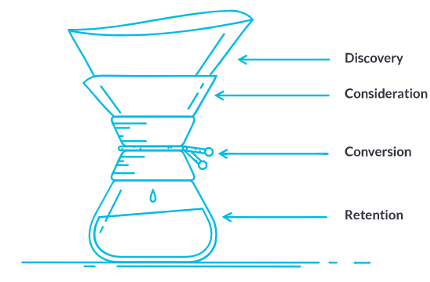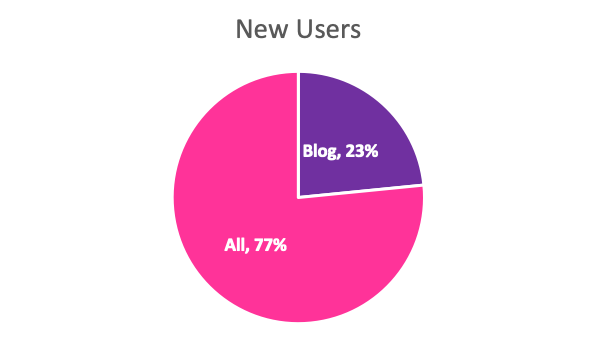Beauty is an industry highly impacted by trends and influencers, and packed with new brands, products, and personalities, which creates a crowded, distracted marketplace. Enter blogging, which is a sound way for brands to gain visibility amidst ever-changing trends. Not only have beauty blogs become a popular source for consumers to learn about products, but great content is also the cornerstone of an effective SEO campaign. And why does that matter? As a strategy, SEO drives an average of 60% of total traffic and 40% of all conversions for our clients. In my role at Stella Rising, I work on beauty brand content marketing to grow awareness and turn readers into buyers, all while reinforcing branding loyalty with current consumers. A well optimized beauty brand blog post will include each of the following:
- SEO optimized title tag, H1 heading (H2, H3, etc.), meta description and URL
- Keyword rich body copy that speaks to frequently searched questions or topics
- Internal links to relevant product and category pages
- Supplemental content like infographics, videos, and images
CONTENT MARKETING, THE BENEFITS:
When reviewing the marketing funnel, top of funnel awareness-based content is often overlooked by brands. Yet value lies in allocating resources to the discovery stage. Content can open the door for a brand to become top of mind, rank for high-volume keywords, acquire links, expand retargeting lists, and, ultimately, lead to assisted conversions.

- Content marketing boosts rankings. Creating content that gets clicks for topically relevant terms will help boost the rankings of related product pages. Internal links can help boost rankings as well by linking to the product page within the blog post and from the product page back to the blog.
- Content can help acquire links. Backlinks from authoritative domains can be a crucial ranking factor and make the site more authoritative.
- Content helps retargeting. High quality content will spur relevant traffic that can be retargeted via social media Social media ads convert, and a blog can help build a larger retargeting audience.
- Content builds email lists: integrated email signup forms on the blog can increase email subscriptions dramatically.
- Content leads to assisted and direct conversions, as it nurtures path to purchase.

Client Snapshot: Percentage of New Users from the Blog vs. All
WHAT TO WRITE ABOUT
Keywords, the search terms that are at the heart of SEO optimizations, can be the foundation for blog content. Keyword research and competitive analysis are critical when deciding which keywords to build content around. A few considerations:
- The Google search engine results page itself is a very useful indicator of what Google wants users to see when they search.
- Keywords that you may think display purchase intent content in Google actually don’t. Instead, keywords like “red lipstick” and “beauty balm”—highly popular products—rank on page one as informational content.
- Product keywords that also yield content-driven results in Google are especially useful for brands because of the opportunity to link to products within the body copy of the blog post, connecting the dots between information and product—and, ideally, leading to a purchase.
A HOW-TO: CONTENT MARKETING FOR BEAUTY BRANDS
Often for blog posts, I recommend focusing on informational terms such as “how to make lipstick last.” Remember: the main goal of content is to answer user’s questions. With that in mind, a good place to start is researching what people have already been asking and providing them with the best answer.
One place to look is in the People Also Ask box, a SERP feature that generates questions that are relevant to the query with drop down answers. Although it can often be difficult to rank for particularly high-volume keywords, especially broad terms like “beauty” or “skincare,” high-volume, relevant keywords should be considered when writing content.
There is significant volume around beauty keywords like “how to contour” or “benefits of hyaluronic acid,” both of which display largely informational results. Of those results, some derive from beauty brand blogs. The key to ranking for terms like these is to use the keyword itself in the body copy, title tag, and H1 tag. A title tag is displayed in the search engine results page as the clickable title for that page. The title tag should describe the content on the page, but it should also be built around the keyword or keywords the page should ideally be ranking for.
WHY YOU SHOULD BLOG, EVEN IN 2020
If a brand sells products that are relevant to a beauty trend or topic, there are endless possibilities for new content to add to the blog. If the content does well and ranks on page one of Google, then it will increase search visibility, bring new potential customers to the site, and increase brand awareness. Even when a brand is in the maturity stage of its lifecycle, there is opportunity to become a relevant voice in the conversation around new and exciting trends that interest consumers and lead to purchases.
REINFORCING A RELATIONSHIP
Blogging can also help foster a post-sale relationship between brand and customer. For example, jane iredale, a clean beauty brand and longtime Stella Rising client, sells a matte liquid foundation. A blog post can be built around questions that are commonly asked by customers that have purchased that foundation. If jane Iredale publishes an article titled “How to Apply jane iredale Matte Liquid Foundation Like a Pro” there is opportunity to attract customers at both top of funnel, bottom of funnel, and post-purchase by providing information that can be useful to all by creating product/brand awareness, discussing the main selling points of the product/brand, and describing the optimal way to use the product itself. Consistently reinforcing the brand in blog content is essential for both brand awareness and creating a sense of community for customers that are already familiar with the brand and/or have purchased products before.
HOW TO MEASURE THE IMPACT OF CONTENT MARKETING FOR BEAUTY
When measuring the success of a blog, there are a few KPIs to review. Traffic increases brand awareness and can help generate soft goal completions such as email sign ups or visits to other pages. In addition, backlinks are one of the most important factors in how Google rates a website’s authoritativeness. Obtaining high quality backlinks from authoritative sites is crucial toward building site authority. It is also important to look at how blog posts are ranking for the keywords they were initially optimized for. While rankings do tend to fluctuate, they can still be an extreme indicator of success.
Ultimately, Google ranks the pages that it believes best answer searcher questions; keep those questions in mind when crafting an article so that chances of ranking upon publication are increased.
NEXT LEVEL MEASUREMENT
At Stella Rising, we use paid tools like SEMrush or Moz to track a website’s rankings and execute off-site performance analysis. Ahrefs is another tool that we use to perform keyword research, competitive analysis, off-site performance, and backlink analysis. The SEMrush tools Answer the Public and topic research help us to generate content topics that brand audiences want to read.
Overall, the most important thing to keep in mind when starting a blog is that the content published represents brand voice. By using data from expert SEO tools, studying the SERPs for keywords that relate to your brand, analyzing competition, and answering questions, your brand can build an SEO optimized blog from the ground up.
HOW AN AGENCY CAN HELP
At Stella Rising, our award-winning SEO team has deep experience working with beauty brands, creating content that not only ranks but also builds brand awareness and leads conversations. Stella Rising can help your brand grow awareness, website authority, audience pools, and so much more. Find out more about the SEO services and content management services we can provide by reaching out to us today.



COMMENTS